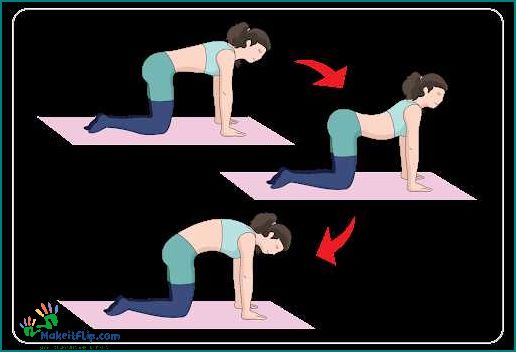Contents
Easy and Safe Techniques for Cracking Your Own Back: A Step-by-Step Guide

Are you looking for relief from back pain? Cracking your own back can be a simple and effective way to alleviate discomfort and tension in your spine. By using specific techniques, you can safely crack your own back at home, without the need for a professional chiropractor.
Cracking your own back involves applying gentle pressure to certain areas of your spine, which releases built-up gas and provides instant relief. However, it’s important to note that cracking your own back should be done with caution and awareness of your body’s limitations.
In this article, we will explore various techniques that you can use to crack your own back. These techniques include stretching exercises, self-massage, and using props such as foam rollers or tennis balls. We will also provide tips on how to maintain a proper posture and avoid potential risks while cracking your own back.
So, if you’re ready to learn how to crack your own back and experience the benefits of spinal relief, read on. With the right techniques and a little practice, you can take control of your own back health and find the relief you’ve been seeking.
Why Crack Your Own Back?

Cracking your own back can provide relief and improve the health of your spine. Here are a few reasons why you might want to learn how to crack your own back:
- Pain relief: Cracking your back can help alleviate pain and tension in the muscles and joints. It can provide temporary relief from discomfort caused by muscle tightness, stiffness, or minor misalignments.
- Increased flexibility: Regularly cracking your back can help improve your flexibility by increasing the range of motion in your spine. This can be beneficial for athletes or anyone looking to enhance their overall physical performance.
- Stress reduction: Cracking your back can release endorphins, which are natural painkillers and mood boosters. This can help reduce stress and promote relaxation.
- Improved posture: By cracking your back, you can correct minor misalignments and improve your posture. This can lead to better spinal alignment and reduce the risk of developing chronic back pain or other related issues.
- Self-care and independence: Learning how to crack your own back gives you the ability to provide self-care and manage minor back issues on your own. It allows you to take control of your own well-being and avoid unnecessary trips to healthcare professionals.
While cracking your own back can provide relief and benefits, it’s important to use safe and proper techniques to avoid injury. Always consult with a healthcare professional if you have any underlying medical conditions or if you’re unsure about performing these techniques on your own.
Relieve Tension and Discomfort
If you’re experiencing tension and discomfort in your back, cracking your own back can provide relief. By using safe and easy techniques, you can target specific areas of your spine to alleviate tension and promote relaxation.
Here are some techniques you can try to crack your own back:
- Self-Massage: Start by massaging the muscles around your spine using your fingertips or a massage tool. Apply gentle pressure and circular motions to help release tension.
- Stretching: Perform gentle stretches that target the muscles in your back. You can try exercises like the cat-camel stretch or the child’s pose to help loosen up your spine.
- Spinal Twist: Lie on your back and bring your knees to your chest. Slowly lower your knees to one side while keeping your shoulders on the ground. Hold this position for a few seconds and then repeat on the other side.
- Using a Foam Roller: Place a foam roller under your back and gently roll back and forth, targeting different areas of your spine. This can help release tension and provide relief.
- Back Arch: Stand with your feet shoulder-width apart and place your hands on your lower back. Slowly arch your back backward, leaning back as far as is comfortable. Hold this position for a few seconds and then return to the starting position.
Remember to listen to your body and stop if you experience any pain or discomfort. If your symptoms persist or worsen, it’s always best to consult with a healthcare professional.
Improve Flexibility and Range of Motion
When it comes to finding relief for your back, learning techniques to crack your own back can be incredibly helpful. However, it’s also important to focus on improving flexibility and range of motion to prevent future discomfort and promote overall spine health.
One effective way to improve flexibility is through stretching exercises. Incorporating regular stretching into your routine can help loosen tight muscles and increase your range of motion. Some beneficial stretches for the back include the cat-camel stretch, child’s pose, and the seated spinal twist.
In addition to stretching, strengthening exercises can also play a key role in improving flexibility and range of motion. Building strength in the muscles that support your back can help stabilize the spine and reduce the risk of injury. Exercises such as bridges, planks, and bird dogs can target these muscles and promote a healthier back.
Another technique to improve flexibility is through the use of foam rolling. Foam rolling can help release tension in the muscles and fascia, allowing for greater mobility and flexibility. By rolling the foam roller along your back, you can target specific areas and alleviate tightness.
It’s important to note that when attempting to improve flexibility and range of motion, it’s crucial to listen to your body and avoid overexertion. Start slowly and gradually increase the intensity and duration of your exercises. If you experience any pain or discomfort, stop immediately and consult with a healthcare professional.
By incorporating these techniques into your routine, you can not only find relief for your back through cracking techniques, but also promote long-term spine health and prevent future discomfort.
Promote Relaxation and Stress Relief
Cracking your own back can provide relief and relaxation to your spine. By using various techniques, you can achieve a sense of calm and reduce stress in your daily life.
One technique to promote relaxation is the self-traction method. This involves lying on your back and gently pulling your knees towards your chest. This action helps to stretch and decompress the spine, relieving tension and promoting a sense of relaxation.
Another technique is the self-massage method. By using your hands or a massage tool, you can apply gentle pressure to the muscles along your spine. This helps to release tension and knots, providing relief and relaxation to your back.
Deep breathing exercises can also aid in promoting relaxation and stress relief. By taking slow, deep breaths and focusing on your breath, you can calm your mind and relax your body. This technique can be done in conjunction with other back cracking techniques to enhance the overall relaxation experience.
It is important to note that while cracking your own back can provide temporary relief, it is not a substitute for professional medical advice or treatment. If you experience chronic or severe back pain, it is recommended to consult with a healthcare professional for proper diagnosis and treatment.
Safe Techniques to Crack Your Own Back
If you’re experiencing back pain or discomfort, cracking your own back can provide relief. However, it’s important to use safe techniques to avoid injury. Here are some safe techniques to crack your own back:
- Stretching: Start by stretching your back muscles to warm them up. You can do simple stretches like the cat-camel stretch or the child’s pose to prepare your back for cracking.
- Self-massage: Use your hands or a foam roller to massage the muscles around your spine. This can help release tension and prepare your back for cracking.
- Twisting: Sit on the edge of a chair and twist your upper body to one side, holding onto the back of the chair for support. Repeat on the other side. This twisting motion can help crack your back safely.
- Back extensions: Lie on your stomach and prop yourself up on your forearms, keeping your hips on the ground. Slowly arch your back, pushing your chest up towards the ceiling. This can help crack your back and relieve tension.
- Using a foam roller: Lie on a foam roller with it positioned vertically along your spine. Slowly roll up and down, allowing the foam roller to massage your back and potentially crack it.
Remember, it’s important to listen to your body and stop if you feel any pain or discomfort. If your back pain persists or worsens, it’s best to consult a healthcare professional for further evaluation.
FAQ about topic How to Crack Your Own Back Easy and Safe Techniques
What are some easy and safe techniques to crack your own back?
There are several easy and safe techniques to crack your own back. One technique is the seated spinal twist, where you sit on the edge of a chair, cross one leg over the other, and twist your upper body in the opposite direction. Another technique is the supine twist, where you lie on your back, bend your knees, and gently rotate your legs to one side while keeping your shoulders flat on the ground. Additionally, you can try the cat-cow stretch, where you get on your hands and knees and alternate between arching your back up like a cat and dropping it down like a cow.
Is it safe to crack your own back?
Cracking your own back can be safe if done properly and with caution. It is important to listen to your body and not force any movements. It is also recommended to start with gentle stretches and gradually increase the intensity. If you experience any pain or discomfort, it is best to stop and consult with a healthcare professional.
What are the benefits of cracking your own back?
Cracking your own back can provide several benefits. It can help relieve tension and stiffness in the muscles, improve flexibility and range of motion, and promote relaxation. It can also help alleviate minor back pain and discomfort. However, it is important to note that cracking your own back should not be used as a substitute for professional medical advice or treatment.
Are there any risks associated with cracking your own back?
While cracking your own back can be safe when done properly, there are some risks involved. If done incorrectly or forcefully, it can lead to muscle strains, sprains, or even more serious injuries. It is important to be cautious and avoid excessive or jerky movements. If you have any pre-existing conditions or are unsure about cracking your own back, it is best to consult with a healthcare professional.
Can cracking your own back help with back pain?
Cracking your own back can sometimes help with minor back pain. It can provide temporary relief by releasing tension in the muscles and promoting better blood flow. However, it is important to address the underlying cause of the back pain and seek appropriate medical treatment if the pain persists or worsens. Cracking your own back should not be relied upon as the sole treatment for chronic or severe back pain.
I’m Diana Ricciardi, the author behind Makeitflip.com. My blog is a dedicated space for mothers and their kids, where I share valuable insights, tips, and information to make parenting a bit easier and more enjoyable.
From finding the best booster seat high chair for your child, understanding the connection between sciatica and hip pain, to exploring the benefits of pooping in relieving acid reflux, I cover a range of topics that are essential for every parent.
My goal is to provide you with practical advice and solutions that you can easily incorporate into your daily life, ensuring that you and your child have the best possible experience during these precious years.
